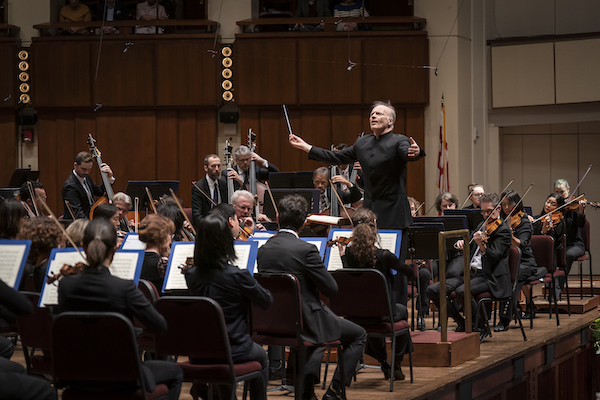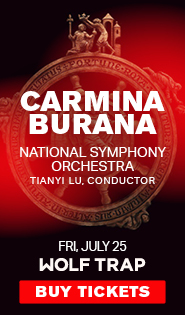Noseda, NSO hit their stride with Beethoven “Pastoral” and Still Second

Gianandrea Noseda conducted the National Symphony Orchestra in music of Beethoven and William Grant Still Saturday night. Photo: Scott Suchman
Gianandrea Noseda continued his “Beethoven-plus” symphonic cycle with the National Symphony Orchestra this week. After the Seventh and Eighth Symphonies, it was backwards to the Sixth Symphony in this second program, heard Saturday evening at the Kennedy Center Concert Hall. (The first performance of this concert, somewhat unusually, was a Friday matinee.)
The African-American composer paired with Beethoven this time was William Grant Still, represented by his Second Symphony (“Song of a New Race”), premiered in 1937. The composer, a contemporary of Louis Armstrong, had broken a barrier with the premiere of his First Symphony (“Afro-American”) in 1931. These two works formed a musical triptych with the lush symphonic suite Africa, from 1930, a portrait that depicted “not the Africa of reality but an Africa mirrored in fancy, and radiantly ideal.”
Grant described the First Symphony as a portrait of earlier generations of African-Americans (“the man of the soil”), with the Second Symphony progressing to “the American colored man of today, in so many instances a totally new individual.” Its four movements, reveling in African-American jazz assimilated into its symphonic surroundings, ripple with hope for a new era in American life.
As a young man, Still taught himself to play a whole host of instruments, learning the art of orchestration from the inside out. He got his professional start playing and arranging music for jazz ensembles led by W.C. Handy, Fletcher Henderson, and Eubie Blake, among others. The rich scoring heard in the first movement reflected that formation: plush violin writing simmering under the pastoral English horn, with low strings pulsing like tom-toms. Cinematic crescendos of brass washed over excellent woodwind ensemble playing, rounding out the picture of the NSO firing on all cylinders.
The second movement, even slower and more expressive than the first, felt like a love scene in a 1930s film, a reminder that Still also worked as a film score composer and arranger around this time. Concertmaster Nurit Bar-Josef handled the passionate violin solos with vibrato-laden richness, and the celesta added sentimental touches. The third movement ambled like an easy-going foxtrot, complete with melodic slides and the sound of brushes on the snare drum.
The fourth movement kept the same breezy sense of confidence, with the three muted trumpets and bass clarinet adding buzz to the finale, capped by a big Hollywood finish. The composer later arranged this movement for Paul Whiteman’s jazz orchestra, which played it a few times in the 1930s, building on the success of its performances of Gershwin’s Rhapsody in Blue from 1924. The latter piece, orchestrated by Ferde Grofé, likely served as a model for Still.
The Still symphony’s generally relaxed tone made it a genial companion piece to Beethoven’s Sixth Symphony (“Pastoral”), which proved the high point so far in Noseda’s traversal of the composer’s orchestral works. With the string sections trimmed back to just under forty players, Noseda led a carefully contained interpretation of this most peaceful of Beethoven’s symphonies, putting the spotlight on the storm scene in the fourth movement.
With titles placed on each movement, Beethoven described the feelings that inspired the symphony, drawn from one of his favorite activities, walking in the countryside around Vienna. The first movement seemed carefree, jaunty in tempo, with rustic horns punctuating the burbling texture of melodies floating over folk-like drones. Clarinet and flute solos adorned the final section, with Noseda not lingering unduly nor never rushing the music.
The conductor kept the brook scene of the second movement placid in feeling, with a stately tempo, emphasizing the water’s motion in the articulation of murmuring inner parts. The little closing vignette with the three birds delighted, a cadenza heard twice from the flute (nightingale), oboe (quail), and two clarinets (cuckoo). Noseda pushed the tempo only in the third movement’s peasant dance scene, but the NSO’s oboe, clarinet, and horn principals all took this spritely pace easily in stride.
The timpani and piccolo, heard only in the fourth movement, added an aura of menace to the storm that blew through the bucolic scene. Noseda drew out the rumbles of the cellos and basses on thunderous tremolos, rather than evoking the storm purely through an excess of speed. Likewise, a well-chosen Allegretto tempo set a gentle tone for the fifth movement, made more vivid through subtle differences of articulation and dynamic shading.
The third installment of the Beethoven cycle combines the Egmont and Coriolan Overtures with the Second Symphonies of Beethoven and George Walker, 7 p.m. May 24 and 25. kennedy-center.org


